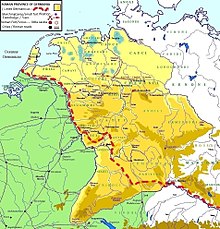Loading AI tools
Short-lived Roman province From Wikipedia, the free encyclopedia
Germania (also sometimes called Germania Antiqua[by whom?]) was a short-lived Roman province for the duration of 16 years under Augustus, from 7 BC to AD 9. The possible capital of this province was Marktbreit (German: Römerlager Marktbreit), a castrum (Roman legionary fortification) with a nearby canaba (Roman vicus) from the period of Emperor Augustus, located 70 km east of the "Limes Germanicus" on the River Main.
| Germania Antiqua Provincia Germania | |
|---|---|
| Province of the Roman Empire | |
| 7 BC–AD 9 | |
 The Roman province of Germania (marked in yellow) | |
| Capital | Marktbreit? |
| Historical era | Antiquity |
• Established | 7 BC |
• Disestablished | AD 9 |
| Today part of | |
The Romans under Augustus began to conquer and defeat the peoples of Germania Magna in 12 BC, having the legati (generals) Drusus and Tiberius leading the legions. By AD 6, all of Germania up to the River Elbe was temporarily pacified by the Romans as well as being occupied by them, with Publius Quinctilius Varus being (unofficially) appointed as Germania's governor.
In 12 BC Nero Claudius Drusus "the elder" crossed the Rhenus to establish Roman control. Many of the Germanic tribes were conquered and by 9 BC he had pushed the border of northern Roman Germania to the Albis (Elbe). Drusus died later that year and was replaced by his brother Tiberius. Tiberius fought a number of smaller wars and eventually left Germania in the hands of various legates who had established friendly relations among the Germans.Augustus, satisfied with the accomplishments of both Drusus and Tiberius, pushed to make Germania Magna (between the Rhenus and Albis) a province of the Roman Empire. The Romans, however, had overestimated their position and found the tribes unwilling to accept the offer of provincial status.In 9 AD under the command of Publius Quinctilius Varus the Romans were caught in a surprise attack while marching through the Teutoburg Forest. The Cherusci tribe, under Arminius (Hermann) destroyed 3 full Legions, the XVII, XVIII, and XIX, resulting in the death of 20,000 Legionaries.[1]
However, the Roman plan to complete the conquest and incorporate all of Magna Germania into the Roman Empire was frustrated when three Roman legions under the command of Varus were annihilated by the German tribesmen in the Battle of the Teutoburg Forest in AD 9. Augustus then ordered Roman withdrawal from Magna Germania (completed by AD 16) and established the boundary of the Roman Empire as being the Rhine and the Danube.

Under Emperors Vespasian and Domitian, the Roman Empire occupied the region known as the Agri Decumates between the Main, Danube, and Rhine rivers. The region soon became a vital part of the Limes Germanicus with dozens of Roman forts. The Agri Decumates were finally abandoned to the Germanic Alemanni, after the Emperor Probus' death (282).[2] Some parts of the earlier province were incorporated into either Germania Inferior or Germania Superior in AD 85.
In Tacitus, Germania Antiqua or Germania Barbara, are synonyms of Germania Transrhenana, also Germania Magna, i.e., the part of Germania on the right side of the Rhine.[3]
Seamless Wikipedia browsing. On steroids.
Every time you click a link to Wikipedia, Wiktionary or Wikiquote in your browser's search results, it will show the modern Wikiwand interface.
Wikiwand extension is a five stars, simple, with minimum permission required to keep your browsing private, safe and transparent.